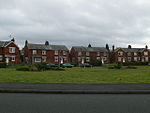Gwersyllt railway station

Gwersyllt railway station serves the area of Gwersyllt in the city of Wrexham in North Wales. It is one of five stations in the Wrexham County Borough. The station is 3.5 km (2¼ miles) north of Wrexham Central on the Borderlands Line and was opened in 1866. The station used to have a signal box at the northern end of the Bidston-bound platform. A short distance to the south a goods-only branch line (part of the North Wales Mineral Railway network, to Brymbo) crossed the route and the abutments of the bridge it utilised still survive (along with a dip in the track formation). One of the line's main engineering features, the five arch stone viaduct over the River Cegidog is situated on this stretch of the line, but to the north of the station.
Excerpt from the Wikipedia article Gwersyllt railway station (License: CC BY-SA 3.0, Authors, Images).Gwersyllt railway station
Hope Street,
Geographical coordinates (GPS) Address Nearby Places Show on map
Geographical coordinates (GPS)
| Latitude | Longitude |
|---|---|
| N 53.073 ° | E -3.018 ° |
Address
Hope Street
LL11 4HT
Wales, United Kingdom
Open on Google Maps




